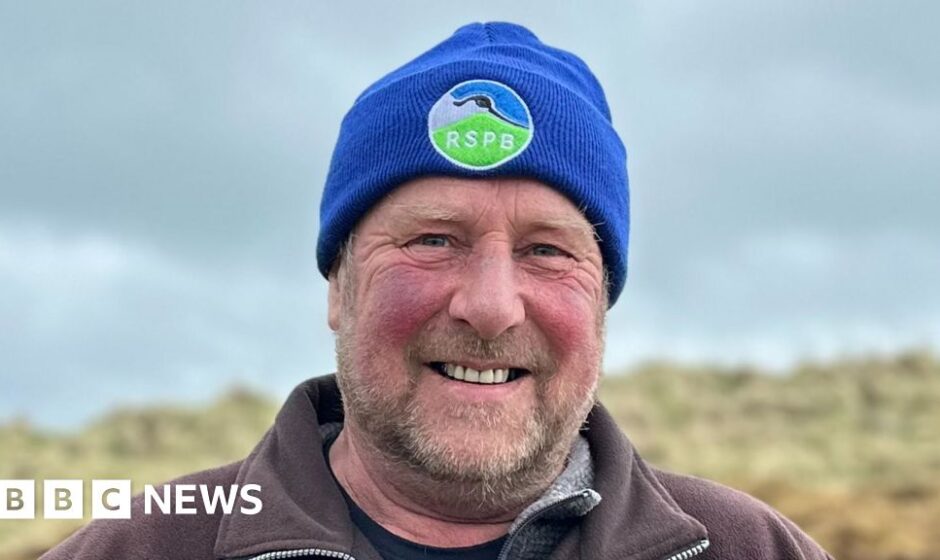 BBC
BBCMultiple tonne bags of nettles from across Northern Ireland have been shipped to Rathlin Island in an effort to support the endangered corncrake bird.
The nettle rhizomes have proven to be a success with the secretive bird as they provide tall vegetation for it to hide in when it returns from wintering in Africa.
The annual dig and planting is part of the Giving Corncrake a Home Project which is ran by the Royal Society for the Protection of Birds (RSPB).
Despite the corncrake population declining since the 1970s, there have been three to five calling males spotted on the island over the last five years.

From October to February, volunteers take part in digging up nettle rhizomes across Northern Ireland.
Volunteers pressure wash the nettles to remove any unwanted seeds, soil or invertebrates, before placing them in tonne bags and taking them to Rathlin Island.
In preparation for their arrival, the ground around the edge of a field on the island is ploughed – or tilled – so the nettle roots can be spread.
Anne Guichard, a RSPB conservation officer, explained that rotten silage bales are then put on top of the nettle roots to “act as fertiliser”.
“Next season there will be nettles growing and hopefully corncrake will choose the place to breed,” she added.
‘They are on the red list’

Liam McFaul, an RSPB warden on Rathlin Island, said the project has “encouraged the corncrake to come back and breed”.
“Corncrakes are an endangered species they are on the red list, if care is not taken they will be totally extinct,” he said.
“We can’t stand by and imagine another generation that will grow up to think: ‘Why did somebody not do something?'”
When the corncrake returns, tall vegetation is in scarce supply so nettles are an ideal habitat due to their fast growing nature.
“They scurry into the nettles and hide straightway, and then they start calling for a mate and sometimes the first brood could be in the nettle bed,” Mr McFaul added.
Corncrakes typically have two broods per breeding season and will also nest in the centre of the field once the grass grows.
Mr McFaul said later in the season the grass is cut “sensitively” and “slowly” from the centre out so the birds can escape.
“We leave a wide area unmown at the edge of the field including the nettle beds as that late cover is equally as important for them growing up and preparing for their migration back to Africa,” he added.
‘Sustainable population’ aim

Fiona Robinson, a RSPB volunteer co-ordinator said they are aiming “to create a sustainable population of corncrake” on Rathlin Island.
“In two years time these [nettles] will be at a lovely height and they [corncrakes] will have a great home,” she said.
“Every male is going to have two or three females, that number has been steady and we are hoping that it is going to have a steady increase.
“We are trying to make it to ten, so we could say we have a sustainable population on the island.”
 Getty Images
Getty ImagesGlenise Morgan participated in the nettle dig at Watertop Farm in Ballycastle during January.
“It is lovely to see the result and realise how productive nettles are,” she said.
“I look forward to hearing that we have more corncrakes in the area.”
‘Listen to nature’

Shaun Boyd is a retired dairy farmer who participated in the RSPB project.
“Sixty years ago whenever I was a wee boy on the farm with my father you would have walked the farm and you could have seen thirty or forty different species of birds on a Saturday evening,” Mr Boyd explained.
“Whenever I retired ten years ago I had time to look at nature and listen to nature, and from then I became interested in it again.
“Being involved in nature is sort of born and bred inside me.”
How to identify a corncrake
Corncrakes are classified in the UK as Red under the Birds of Conservation Concern 5.
This secretive bird gives a rasping rattle for its breeding call – mostly heard at night, sometimes for hours on end.
They prefer to nest in meadows and hay fields in areas with lots of tall plant cover, where they spend most of their time hidden from view.
They are summer visitors to NI and parts of Scotland, wintering in central and southern Africa.
Corncrakes are round-bodied and long-necked, like a water rail, but with a short, stubby bill.
The plumage is mostly yellowish-brown, with darker streaks on the back and pale bars on the flanks. There are grey patches on the throat and above the eye.
#Nettle #roots #arrive #support #corncrakes



